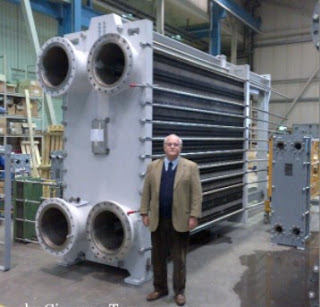10 Good reasons to use a Plate & Frame Gasketed Heat Exchanger GPHE
1. High thermal efficiency - close temperature approach
In these days Heat Recovery is a must in every new project, therefore a unit able to handle small LMTD (till 1°C) like in District Heating plants represents a huge tool to reach ambitious low energy consumption
2. Reduced Footprint. In comparison with a traditional Shell & Tube Heat Exchanger, size ratio. is 1:9. Furthermore Shell & Tube HX requires an additional free space available for extraction of tube bundle for maintenance.
In case of System Builders manufacturing skid mounted unit, this advantage allows more compact executions, in terms of size and weight
It is possible to improve performance with insertion of turbolator on tube bundle, but results are limited and not exactly predictable.
PHE software can exactly design unit for the new duty required (Plate arrangement, mixing to get theta required, pressure drop max allowable etc.). For this reason there is no need to add large extra margin on surface at the beginning (like for Shell & Tube HX) because plate number can be increased (or reduced) if necessary.
5. No possible mixing between two fluids. Special design of gasket (double hole.protection) on the area around inlet. If fluid in case of possible damage of rounded one is passing through, second triangolar gasket will avoid possible mixing Leaking will be on small channels inside gaskets (escape routes) out of plate pack..
6.Both sides cleanable. Opening plate pack is giving opportunity to acces to both sides of plates fir cleaning and maintenance. Once disassembled plates can be cleaned immersed in chemical bath. Shell & Tubes HX's are easy to inspect tube bundle, but not so easy on shell side.Semiwelded PHE, Shell & Plate HX's got same problem. Compabloc HX's have access on both side, but lower part of plate corrugation can not be conpletely cleaned.
7. Small hold up (internal volume). PHE at the beginning of use for production of domestic hot water was called "istantaneous HX" because people used to wait for a while hot water from traditional boiler was impressed by prompt reaction after valve opening. In other word, due to small internal volume reaction was much faster than traditional boier or Shell &bTubes HX. This feature is appreciated in many other applications (e.g. reactor thermostatation, metal treatmen baths etc.).
Generally speaking an accurate temperature control system is a guarantee of good energy managagement like in District Heating plants.
8.High turbolence - self cleaning Corrugation pattern is creating helix flow circulation that due to pressure drop as driving force is creating turnolence. In a PHE limit value from laminar flow to turbolent flow is Reynolds > 200 while in Shell & Tube HX is Reynolds > 1,500. Due to geometry of plate herring bone pattern, velocity in PHE is higher than in Shell & Tube HX, so that fouling is reduced.













Commenti
Posta un commento